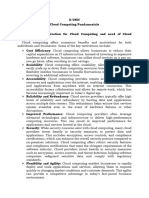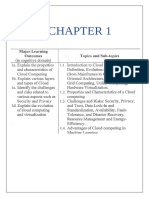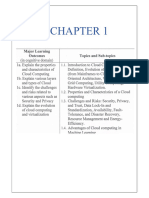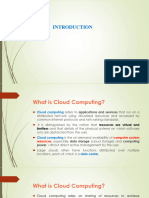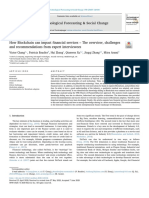0 ratings0% found this document useful (0 votes)
12 viewsIntroduction to Cloud Computing
These are my sources
Uploaded by
Geetha.R AcharCopyright
© © All Rights Reserved
Available Formats
Download as PDF, TXT or read online on Scribd
0 ratings0% found this document useful (0 votes)
12 viewsIntroduction to Cloud Computing
These are my sources
Uploaded by
Geetha.R AcharCopyright
© © All Rights Reserved
Available Formats
Download as PDF, TXT or read online on Scribd
You are on page 1/ 8
Introduction to Cloud Computing
1.Definition and Characteristics
What is Cloud Computing? Cloud computing is
a technology that allows users to access and
store data, applications, and services over the
internet ("the cloud") rather than on local
servers or personal computers. It provides a
flexible, scalable, and cost-effective way to
manage IT resources, enabling users to access
computing power, storage, and applications
from anywhere with an internet connection.
Key Characteristics of Cloud Computing:
1. On-Demand Self-Service:
o Users can provision computing resources
like storage, processing power, and
network bandwidth as needed without
requiring human intervention from the
service provider.
2. Broad Network Access:
o Cloud services are accessible over the
network through standard mechanisms,
enabling access from various devices such
as laptops, smartphones, tablets, and
desktops.
3. Resource Pooling:
o Cloud providers pool computing
resources to serve multiple consumers
using a multi-tenant model, with
resources dynamically assigned and
reassigned according to consumer
demand. This pooling enables economies
of scale and efficient resource utilization.
4. Rapid Elasticity:
o Cloud services can be quickly scaled up or
down to accommodate fluctuations in
demand. This elasticity is often perceived
as infinite to the consumer, who can
purchase services in any quantity at any
time.
5. Measured Service:
o Cloud systems automatically control and
optimize resource use by leveraging a
metering capability at some level of
abstraction appropriate to the type of
service (e.g., storage, processing,
bandwidth). This allows for a pay-per-use
or chargeback model, where customers
pay only for what they use.
Benefits of Cloud Computing:
• Cost Efficiency: Reduces the need for capital
investment in hardware and software; users
pay only for what they use.
• Scalability: Resources can be scaled up or
down based on demand, allowing for flexible
operations.
• Accessibility: Services and data can be
accessed from anywhere with an internet
connection.
• Disaster Recovery: Cloud providers often
offer robust disaster recovery solutions,
ensuring business continuity.
• Automatic Updates: Cloud providers handle
software updates and maintenance, freeing
up IT staff to focus on other tasks.
Challenges of Cloud Computing:
• Security Concerns: Storing sensitive data off-
premises raises concerns about data privacy
and protection.
• Downtime: Dependence on internet
connectivity means that network issues can
lead to service outages.
• Compliance Issues: Meeting regulatory
compliance requirements can be challenging
when data is stored across different
jurisdictions.
• Limited Control: Users may have limited
control over the infrastructure and may rely
on the provider’s policies and procedures.
2.Evolution of Cloud Computing
Historical Perspective:
• Cloud computing has its roots in the 1960s
with the concept of time-sharing on
mainframe computers, allowing multiple
users to access a central computer
simultaneously.
• The 1990s saw the rise of the internet and the
development of virtualization technology,
which laid the foundation for modern cloud
computing.
• In the early 2000s, companies like Amazon,
Google, and Microsoft began offering cloud-
based services, marking the beginning of the
cloud computing era.
• Over time, cloud computing evolved to
include various service models (IaaS, PaaS,
SaaS) and deployment models (public,
private, hybrid, community clouds).
Comparison with Traditional Computing
Models:
• Traditional Computing:
o Requires significant upfront investment in
hardware and software.
o Maintenance, upgrades, and scaling are
manual and can be costly.
o Limited to the physical infrastructure
owned by the organization.
o Access to resources is confined to the
organization’s network.
• Cloud Computing:
o Minimal upfront costs; users pay for
services as they go.
o Scaling is automatic and cost-effective.
o Resources are virtual and can be accessed
globally over the internet.
o Services are managed and maintained by
cloud provider.
Driving Factors Behind Cloud Adoption:
• Cost Savings: Organizations can reduce capital
expenses and operational costs by leveraging
cloud services.
• Agility and Innovation: Cloud computing
enables faster deployment of applications and
services, fostering innovation.
• Global Reach: Businesses can expand their
reach and provide services to a global
audience with ease.
• Focus on Core Business: Cloud services allow
businesses to focus on their core activities,
leaving IT infrastructure management to the
cloud provider.
• Environmental Impact: Cloud computing can
lead to more efficient use of resources and
reduced energy consumption, contributing to
sustainability efforts.
You might also like
- You, Me, PSHE: A Scheme of Work For The Primary School100% (2)You, Me, PSHE: A Scheme of Work For The Primary School286 pages
- FALLSEM2024-25_BCSE408L_TH_VL2024250101831_2024-07-18_Reference-Material-INo ratings yetFALLSEM2024-25_BCSE408L_TH_VL2024250101831_2024-07-18_Reference-Material-I82 pages
- Data communication using cloud computingNo ratings yetData communication using cloud computing7 pages
- Class Notes Introduction To Cloud ComputingNo ratings yetClass Notes Introduction To Cloud Computing2 pages
- Antim Prahar Cloud Computing For Business 2024No ratings yetAntim Prahar Cloud Computing For Business 202467 pages
- Cloud Computing Section-1: Prepared by Manish Kumar Aery. IET Bhaddal Technical Campus, RoparNo ratings yetCloud Computing Section-1: Prepared by Manish Kumar Aery. IET Bhaddal Technical Campus, Ropar16 pages
- Chapter 1 - Overview of Cloud ComputingNo ratings yetChapter 1 - Overview of Cloud Computing13 pages
- Cloud Computing: Harnessing the Power of the Digital Skies: The IT CollectionFrom EverandCloud Computing: Harnessing the Power of the Digital Skies: The IT CollectionNo ratings yet
- November 2016 (v2) QP - Paper 2 CIE Geography IGCSENo ratings yetNovember 2016 (v2) QP - Paper 2 CIE Geography IGCSE20 pages
- How Blockchain Can Impact Financial Services - The Overview, Challenges and Recommendations From Expert Interviewees100% (1)How Blockchain Can Impact Financial Services - The Overview, Challenges and Recommendations From Expert Interviewees12 pages
- SL No Dist Name AC No and Name Name of The BLO Mobile of The BLO Part No and NameNo ratings yetSL No Dist Name AC No and Name Name of The BLO Mobile of The BLO Part No and Name12 pages
- Deindustrialisation and Popular Music Punk and Post-Punk in Manchester, Düsseldorf, Torino and Tampere (Giacomo Bottà)No ratings yetDeindustrialisation and Popular Music Punk and Post-Punk in Manchester, Düsseldorf, Torino and Tampere (Giacomo Bottà)222 pages
- The Functions of The Delphic Amphictyony Before 346 BCE1: Hugh BowdenNo ratings yetThe Functions of The Delphic Amphictyony Before 346 BCE1: Hugh Bowden17 pages
- Intrinsic Valuation - Aswath Damodaran PDFNo ratings yetIntrinsic Valuation - Aswath Damodaran PDF19 pages
- NCERT Solutions For Class 12 Macro Chapter 4 - Determination of Income and Employment - .No ratings yetNCERT Solutions For Class 12 Macro Chapter 4 - Determination of Income and Employment - .8 pages
- You, Me, PSHE: A Scheme of Work For The Primary SchoolYou, Me, PSHE: A Scheme of Work For The Primary School
- FALLSEM2024-25_BCSE408L_TH_VL2024250101831_2024-07-18_Reference-Material-IFALLSEM2024-25_BCSE408L_TH_VL2024250101831_2024-07-18_Reference-Material-I
- Cloud Computing Section-1: Prepared by Manish Kumar Aery. IET Bhaddal Technical Campus, RoparCloud Computing Section-1: Prepared by Manish Kumar Aery. IET Bhaddal Technical Campus, Ropar
- Cloud Computing: Harnessing the Power of the Digital Skies: The IT CollectionFrom EverandCloud Computing: Harnessing the Power of the Digital Skies: The IT Collection
- November 2016 (v2) QP - Paper 2 CIE Geography IGCSENovember 2016 (v2) QP - Paper 2 CIE Geography IGCSE
- How Blockchain Can Impact Financial Services - The Overview, Challenges and Recommendations From Expert IntervieweesHow Blockchain Can Impact Financial Services - The Overview, Challenges and Recommendations From Expert Interviewees
- SL No Dist Name AC No and Name Name of The BLO Mobile of The BLO Part No and NameSL No Dist Name AC No and Name Name of The BLO Mobile of The BLO Part No and Name
- Deindustrialisation and Popular Music Punk and Post-Punk in Manchester, Düsseldorf, Torino and Tampere (Giacomo Bottà)Deindustrialisation and Popular Music Punk and Post-Punk in Manchester, Düsseldorf, Torino and Tampere (Giacomo Bottà)
- The Functions of The Delphic Amphictyony Before 346 BCE1: Hugh BowdenThe Functions of The Delphic Amphictyony Before 346 BCE1: Hugh Bowden
- NCERT Solutions For Class 12 Macro Chapter 4 - Determination of Income and Employment - .NCERT Solutions For Class 12 Macro Chapter 4 - Determination of Income and Employment - .




